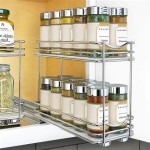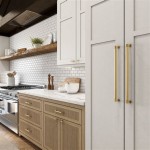Kitchen Under Cabinet Lighting Ideas: Illuminate Your Workspace
Under-cabinet lighting represents a functional and aesthetic enhancement to any kitchen. Properly implemented, it elevates task lighting, improves ambiance, and highlights design features. This article explores various under-cabinet lighting options, installation considerations, and factors to consider when selecting the ideal solution for a particular kitchen space.
Benefits of Under Cabinet Lighting
The addition of under-cabinet lighting extends beyond mere illumination; it offers a multitude of practical and design-centric advantages. These benefits contribute to a more efficient, visually appealing, and safer kitchen environment.
Enhanced Task Lighting: Kitchen countertops are often shadowed by upper cabinets, especially during evening hours or in kitchens with limited natural light. Under-cabinet lighting directly addresses this issue by providing focused illumination on work surfaces. This improved visibility facilitates safer and more precise food preparation, reducing the risk of accidents involving knives or other kitchen tools. Increased visibility also makes it easier to read recipes, measure ingredients accurately, and perform other detailed tasks.
Improved Ambiance: Under-cabinet lighting is not solely functional; it also contributes substantially to the overall ambiance of the kitchen. The soft, diffused light emanating from beneath the cabinets creates a warm and inviting atmosphere. This is especially beneficial in kitchens that also function as dining or gathering spaces. The ability to dim or adjust the color temperature of the lights provides further control over the kitchen's atmosphere, allowing homeowners to tailor the lighting to suit different moods and occasions. For instance, a warm, golden light can create a cozy and relaxing environment, while a bright, white light can be used for more focused tasks.
Highlighting Design Features: Under-cabinet lighting can be strategically used to accentuate specific design features within the kitchen. When directed towards a backsplash, it can draw attention to intricate tiling, natural stone, or other decorative elements. Similarly, it can highlight countertop materials, such as granite or quartz, enhancing their natural beauty and texture. By carefully positioning and adjusting the intensity of the lights, designers can create focal points and enhance the overall visual appeal of the kitchen.
Increased Safety: Beyond making it easier to see while cooking, under-cabinet lighting also contributes to overall kitchen safety. By illuminating potential hazards, such as spills or dropped objects, it reduces the risk of slips and falls. This is particularly important for elderly individuals or those with limited mobility. Furthermore, well-lit countertops make it easier to clean and maintain the kitchen, preventing the buildup of dirt and bacteria.
Energy Efficiency: Modern under-cabinet lighting options, such as LED lights, are highly energy-efficient. They consume significantly less electricity than traditional incandescent or fluorescent lights, resulting in lower energy bills and a reduced carbon footprint. The long lifespan of LED lights also minimizes the need for frequent replacements, further reducing maintenance costs and environmental impact.
Types of Under Cabinet Lighting
The market offers a diverse selection of under-cabinet lighting options, each with its unique characteristics, advantages, and disadvantages. Understanding the different types allows for selecting the best fit for the kitchen's design, budget, and specific lighting needs.
LED Strip Lights: LED strip lights are a popular and versatile choice for under-cabinet lighting. They consist of a flexible circuit board populated with small LED chips. These strips are typically adhesive-backed, making them easy to install on the underside of cabinets. LED strip lights offer several advantages, including energy efficiency, long lifespan, and customizable lengths. They can be cut to fit specific spaces, and many models are dimmable, allowing for adjustable brightness levels. The color temperature of LED strip lights can also be adjusted, offering a range of options from warm white to cool white. However, the light output from individual LED strip lights may be less intense compared to other options, and it's important to choose a reputable brand to ensure consistent color and performance.
LED Puck Lights: LED puck lights are small, circular lights that are typically surface-mounted to the underside of cabinets. They are available in both wired and wireless options, offering flexibility in installation. Wired puck lights require a power source and may require professional installation, while wireless puck lights operate on batteries and can be easily installed without the need for wiring. LED puck lights provide a concentrated beam of light, making them suitable for highlighting specific areas or objects. They are often used to illuminate countertops, backsplashes, or display items. However, the focused nature of the light may create hotspots, and multiple puck lights may be needed to achieve even illumination.
LED Light Bars: LED light bars are linear fixtures that offer a more uniform and diffused light output compared to LED strip lights or puck lights. They are typically longer than puck lights and are designed to span the length of the cabinet. LED light bars are available in various lengths and light intensities, making them suitable for a wide range of kitchen sizes and lighting needs. They are often used in kitchens with long stretches of countertop, where even illumination is desired. LED light bars can be surface-mounted or recessed into the underside of cabinets, providing a clean and integrated look. However, they may be more expensive than other options, and professional installation may be required for recessed models.
Xenon Lights: Xenon lights offer a bright, white light that closely resembles natural daylight. They are often used in kitchens where accurate color rendering is important, such as when preparing visually complex dishes. Xenon lights are more energy-efficient than traditional incandescent lights but less efficient than LED lights. They also have a shorter lifespan than LED lights, requiring more frequent replacements. Xenon lights produce heat, which can be a concern in enclosed spaces such as under cabinets. They are typically more expensive than LED lights and are becoming less common as LED technology continues to improve.
Fluorescent Lights: Fluorescent lights were a popular choice for under-cabinet lighting in the past, but they are now being replaced by more energy-efficient and versatile LED lights. Fluorescent lights offer a diffused light output and are relatively inexpensive. However, they consume more energy than LED lights and have a shorter lifespan. Fluorescent lights also contain mercury, which requires special disposal procedures. They can also flicker, which can be distracting to some people. Due to these drawbacks, fluorescent lights are generally not recommended for under-cabinet lighting in modern kitchens.
Key Considerations for Installation and Selection
Proper installation and selection are crucial for maximizing the effectiveness and longevity of under-cabinet lighting. Careful consideration of several factors ensures optimal performance and aesthetic appeal.
Power Source and Wiring: The type of power source and wiring required depends on the type of under-cabinet lighting chosen. Wired options require access to an electrical outlet and may necessitate professional installation. Wireless options, such as battery-powered lights, offer greater flexibility but require regular battery replacements. When planning the wiring, it is essential to consider the placement of outlets and the routing of wires to ensure a clean and safe installation. It's recommended to consult with a qualified electrician to ensure the electrical work adheres to local building codes and safety standards.
Placement and Spacing: The placement and spacing of under-cabinet lights significantly impact the overall illumination of the countertop. Lights should be positioned to provide even coverage without creating shadows or hotspots. As a general rule, lights should be placed close to the front edge of the cabinet to maximize illumination on the work surface. For longer stretches of countertop, multiple lights may be needed to ensure consistent brightness. The spacing between lights should be determined based on the light output of the individual fixtures and the desired level of illumination. Experimentation with different placements and spacings is recommended to achieve the optimal lighting effect.
Dimmability and Color Temperature: Dimmability and color temperature are important features to consider when selecting under-cabinet lighting. Dimmable lights allow for adjusting the brightness level to suit different tasks and moods. A dimmer switch provides control over the intensity of the light, allowing for creating a brighter environment for food preparation or a more subdued ambiance for dining. Color temperature refers to the warmth or coolness of the light, measured in Kelvin (K). Warmer color temperatures (e.g., 2700K-3000K) produce a soft, yellowish light, while cooler color temperatures (e.g., 4000K-5000K) produce a bright, white light. The choice of color temperature depends on personal preference and the desired ambiance of the kitchen.
Light Quality and CRI: Light quality is an important factor to consider, especially for tasks that require accurate color rendering. The Color Rendering Index (CRI) is a measure of how accurately a light source renders colors compared to natural daylight. A CRI of 80 or higher is generally recommended for kitchen lighting, as it ensures that colors appear vibrant and true to life. High-CRI lights make it easier to distinguish between different ingredients and ensure that the finished dish looks as intended. When selecting under-cabinet lighting, it's important to check the CRI rating to ensure that the lights provide accurate color rendering.
Style and Aesthetics: The style and aesthetics of under-cabinet lighting should complement the overall design of the kitchen. Lights should be chosen that blend seamlessly with the cabinets and other fixtures. Linear light bars offer a sleek and modern look, while puck lights provide a more traditional aesthetic. The finish of the lights should also be considered, with options such as brushed nickel, stainless steel, and black available to match the hardware and appliances in the kitchen. The goal is to create a cohesive and visually appealing lighting scheme that enhances the overall beauty of the kitchen.
By carefully considering these factors, homeowners can select and install under-cabinet lighting that enhances both the functionality and aesthetics of their kitchens. A well-lit kitchen is a safer, more efficient, and more enjoyable space to cook, dine, and gather.

Undercabinet Lighting Ideas Light Supplier

Diy Cabinet Lighting Easy And Affordable Ideas To Brighten Up Your Home Simple Blog

How To Buy Under Cabinet Lighting Ideas Advice Lamps Plus

Best Under Cabinet Lighting Ideas Assurance Electrical

4 Under Cupboard Lighting Ideas To Make Your Kitchen Pop Handyman Connection

Must Have Under Cabinet Lighting Ideas For Your Kitchen Design

Why Under Cabinet Lighting Is A Good Idea For Your Kitchen

Under Cabinet Lighting Tips And Ideas Advice Lamps Plus

How To Choose And Install Led Strip Lights For Kitchen Cabinets

25 Best Kitchen Lighting Ideas 2024 Moonbeam Lightingmoonbeam Blog








